The Art Shroud by Nayanna Chakrbarty
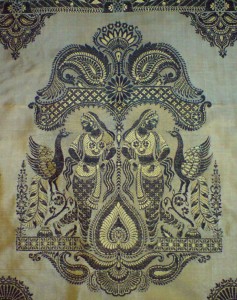
Textile and ancient literature when blended together can create a unique learning experience. The national costume of the Indian woman — the ‘saree’ which dates back to 2800-1800 BC — expresses these sentiments. Every state of India, defines its saree styling with different motifs and patterns based on its cultural influence and habitat. The southern states of India derive their designs from carvings made on temple pillars and archways. One particular eastern style of saree known as the Baluchari specializes in depicting folklore and translates momentous scenes from the epics of Ramayana and Mahabharata.
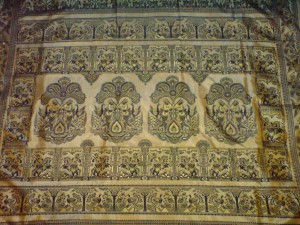
Baluchari designs are woven in silk and epitomize some of the landmark incidents from the Mahabharata – the confrontation of the armies of Kauravas and Pandavas at the Kurukshetra battlefield, (http://en.wikipedia.org/wiki/Kurukshetra_War ) the agony of Bhishma, the grandsire of the Kauravas and the Pandavas, lying on a bed of arrows. He was so blessed that he could decide the time of his demise from this world. (Introduction of Bhishma http://en.wikipedia.org/wiki/Bhishma ) These epics are the backbone of Indian heritage and there are innumerable soul stirring events that can be encapsulated through weaving and painting. Another favorite scene is the depiction of Lord Krishna driving the chariot of Arjun, taking him to the center of the battlefield and narrating to him the essence of Srimad Bhagavad Gita. (Srimad Bhagavad Gita http://en.wikipedia.org/wiki/Bhagavad_Gita ) There are lessons to be learned from these patterns which many are ignorant of. We can only narrate a fraction of the meaning of these motifs because these epics were written with a purpose and are transcendental in nature.
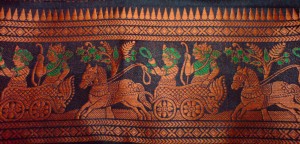
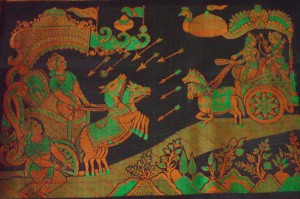
Scenes from the Ramayana are elaborate and distinct where the most common backdrops are the exile of Lord Rama, his wife Sita and his brother, Lord Laxmana from their kingdom of Ayodhya and their meeting with the Simian God, Lord Hanuman. (A short narration on Lord Hanuman http://www.hinduism.co.za/hanuman.htm ) The great devotee that he is, Lord Hanuman is always depicted bowing with humility at their feet. He plays an instrumental role in locating Goddess Sita when she was abducted by demon king Ravana and finding the right herb Sanjivani, to save the life of Lord Laxmana.
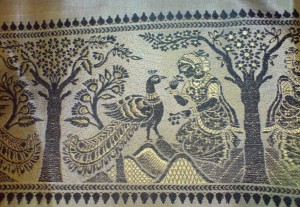
Lord Hanuman is often portrayed in a flying stance, carrying a mountain on his hand. The legend behind this is when Lord Laxmana was wounded in a battle with Ravana, he was critical. The only way he could survive was if he was given a special herb. Lord Hanuman volunteered to find this potential remedy and flew to the Dunagiri mountain. Amongst a variety of vegetation, he was unsure of which the right one was and as time was running out, he lifted the whole mountain and rushed back.
Besides illustrating epics, Baluchari saree borders are weaved with symbolical designs like conch shell, lotus, wheel, bow and arrow. Lord Vishnu, the god of preservation is always depicted with a conch in his hand. The conch is played in several auspicious ceremonies and its resonance emits positive vibrations. It provides a welcoming atmosphere for the deities to partake in the rituals. The battle of Kurukshetra too began when the conch was sounded at dawn and ended for the day, when the conch was sounded again at sunset.
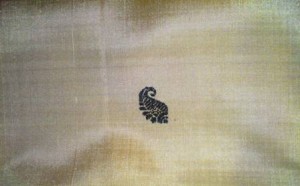
The lotus flower denotes the presence of Goddess Laxmi, the goddess of fortune. Lord Brahma, the creator of the universe and the goddess are depicted seated on a lotus. The lotus-eyed one is another name of Lord Vishnu. The lotus has a lot of significance associated with the chakras of the human body as well.
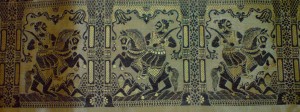
The bow and arrow depicted in motifs extends its significance with the great archer Arjun from Mahabharata.
The wheel motif has several interpretations. Some wheels depict epochs while others signify the chariot wheels that Lord Krishna drove and took Arjun to the core of the battlefield. Some wheels explain the various battle strategies and formations that were used to outmaneuver the enemy during the Kurukshetra war.
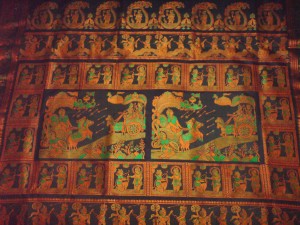
Kantha saree is another style of saree from eastern India that translates literature in art form. This stitch is used to describe folklores and the most popular among them is the story of Behula and her husband Lakhinder. Once Lakhinder’s father had offended Goddess Manasa and she taught him a lesson by sending a snake to bite his son on his wedding night. In those times, it was believed that a person deceased from a snakebite was still alive and could be revived by a resourceful snake-charmer. So the body was set afloat on a boat and allowed to wander across the river. Behula decided to remain next to her deceased husband’s body and sailed across the ocean. After a lot of hardships and angst, she managed to appease the goddess who then by her benediction brought Lakhinder back to life. (Behula Lakhinder Folklore in detail http://www.pantheon.org/articles/m/manasa.html )
The widely used Kantha motifs are solar motifs depicting the power of the sun and energy from fire, the swastika which depicts a sign of good fortune, the tree of life that expresses fertility and abundance while the “Kalka†represents a mango leaf which is sometimes also stylized as flames. Mango leaves are considered auspicious in most Vedic rituals. Kantha patterns are embroidered on bedspreads, handbags, cushion covers, tablemats and so on. They can be mounted on frames and can be used as exquisite wall hangings.
Folklores are still existent and we can give some of the credit to the workmanship of the artisans who entice their audience with vibrant embroidery threads and paint true to life colors that beckons us to take a journey back in time. Art and its various forms can be best appreciated with the comprehension of literature.
You can find more about Nayanna Chakrbaty’s work at http://www.original-writer.com/
